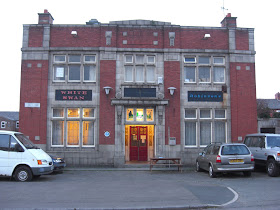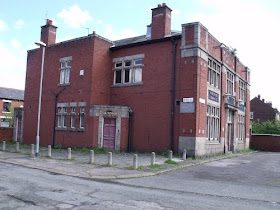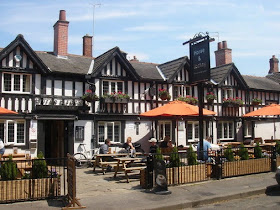The White Swan, known locally as the 'Mucky Duck', was sold by Robinson's in 2011 and closed without much ceremony late that year. 2012 has brought better news as the local Ladybarn Social Club (the former British Legion) has apparantly bought it as of October [1]. There are plans to reopen the White Swan and hopefully go someway to restoring what was once a fine public house with a traditional interior.
White Swan, Green Street, Ladybarn. (c) Eccles Express at gostreet.
CAMRA reports that some of these original features - the etched glass and carved wood bar - are gone, but the ceramic tiling, etched off-sale sign and ornate toilets remain. The side entrance's 'outdoor' sign also remains and below are one of many bands who played in the White Swan's upstairs venue called Creative Space.
White Swan, Green Street, Ladybarn. (c) Phil Portus.
The vault and a front room have been
closed for years so only the main bar had been serving to a small but
loyal band of locals (and music fans for the Friday night shows
which ran since the 1980s). There is a wonderful blog post at thisiswhereiamthisiswhereiwas describing the White Swan and her locals:
It's a quiet, almost abandoned pub that doesn't
even look like it's open. It reminds me of the Winchester from Shaun of the
Dead, but without customers. It does have some customers though. My favourites
are Pat... a lovely Irish man with a great, grey tash who always refers to Manchester United as the
"Red Machine". He drinks 2 pints of lager at
the same time. Joe is also a smashing Irish chap whose shirt is always way too
wide open revealing a large chest that has seen one too many bitters and
whiskeys...
White Swan, Green Street, Ladybarn. (c) toppictures.
There are reports that the White Swan will indeed be reopening its doors under the Ladybarn Social Club in early 2013 after some minor refurbishments. We look forward to visiting this soon-to-be-reborn Manchester classic...

White Swan, Green Street, Ladybarn. (c) Eccles Express at gostreet.
1. www.camrahops.com/guide/004000/Pub004518.htm.
2. http://thisiswhereiamthisiswhereiwas.blogspot.co.uk/2011/05/white-swan-pub-ladybarn-manchester-m14.html.

































